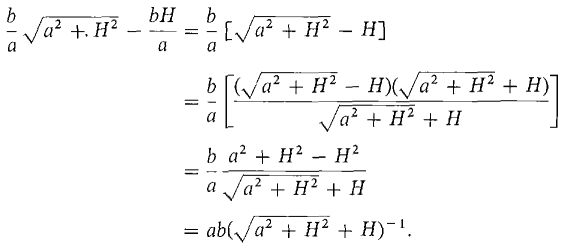| The ebook Elementary Calculus is based on material originally written by H.J. Keisler. For more information please read the copyright pages. |

|

Home  Limits, Analytic Geometry, and Approximations Limits, Analytic Geometry, and Approximations  Ellipses and Hyperbolas Ellipses and Hyperbolas  Hyperbolas: Branches and Limits Hyperbolas: Branches and Limits |
|||||||||||||||||||||






|
|||||||||||||||||||||
Hyperbolas: Branches and Limits
Using derivatives and limits, we can get additional information that is helpful in sketching the graph of a hyperbola. By solving the equation
for y as a function of x, we see that the upper and lower branches have the equations upper branch:
lower branch:
We concentrate on the upper branch. Its first two derivatives, after some algebraic simplification, come out to be
Thus the first derivative is zero only at x = 0 (the vertex), and the second derivative is always positive. We have the following table of values for the upper branch.
All the limit computations are easy except for dy/dx, which we work out for x → ∞. Let H be positive infinite.
We carry out a similar computation for the limit as x →-∞. Let H be positive infinite.
The table shows that the upper branch is almost a straight line with slope -b/a for large negative x and almost a straight line with slope b/a for large positive x. In fact, we shall show now that the lines y = bx/a, y = -bx/a are asymptotes of the hyperbola. That is, as x approaches ∞ or -∞, the distance between the line and the hyperbola approaches zero. We show that the upper branch approaches the line y = bx/a as x→∞; that is,
Let H be positive infinite. Then
This is infinitesimal, so the limit is zero.
|
|||||||||||||||||||||
Home  Limits, Analytic Geometry, and Approximations Limits, Analytic Geometry, and Approximations  Ellipses and Hyperbolas Ellipses and Hyperbolas  Hyperbolas: Branches and Limits Hyperbolas: Branches and Limits |
|||||||||||||||||||||
Last Update: 2006-11-05









